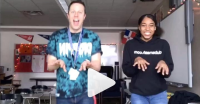An Unconventional Approach to Culturally Responsive Pedagogy
A teacher who dances with his students says the dancing is not what’s important—giving students a sense of ownership in the room is.
Your content has been saved!
Go to My Saved Content.When I started working as a Spanish teacher at Bellaire High School in Houston, Texas, in 2018, I was immediately immersed in the diverse cultures of a large, urban, Title I public school. I set about trying to learn about my students and their interests, and soon I found myself getting an education on the music they listened to and how they danced to it.
As we built a community in the classroom and developed stronger teacher-student bonds, we started making Dubsmash dance videos on Fridays when my students finished their work for the week. Dubsmash is a smartphone app that allows users to video themselves performing brief dance challenges—it’s a supportive digital community.
I began to see firsthand many of the core principles of Christopher Emdin’s #HipHopEd, and his book For White Folks Who Teach in the Hood… and the Rest of Y’all Too helped me better understand just why what I was doing was working so efficiently as a community-building tool that increased students’ engagement with our academic work.
To start this work, I implemented Emdin’s idea of cogens, or co-generative dialogues, to get to know my student population better. Cogens are dialogues between students and teachers that foster a classroom culture that helps meet students’ social and emotional needs.
While I have implemented cogens in different ways, perhaps the most successful has been how I introduce them into the classroom from the first week of school. Rather than begin the year with course content or icebreakers, I instead begin with conversations about culture in which everyone in our classroom community learns about who is in the room and what parts of their culture they value the most.
I form listening circles in which students share information about the types of music they’re listening to, the TV shows they’re watching, and their favorite recent movies. I then compile a list on the board. While students enjoy discussing their interests, this also gives me valuable information that I can use to tailor my teaching to be more culturally responsive to the people in the room.
By doing listening circles such as these, I was able to see my students’ interest in hip-hop dance, which encouraged my students and me to form a cogen in which the students took on leadership roles to teach other students and me how to dance.
Dancing worked for me, but dancing is not the methodology—allowing students to bring their culture into the room and making a genuine effort to listen is. The end result could be a classroom community that discusses music, plays chess, draws, or does yoga together. Although these activities may take place during lunch or after school, they encourage students to enter the classroom with more ownership of the space, which can be transformative for the learning experience.
After a few months of making Dubsmash videos, my students encouraged me to create an Instagram account to post our dance videos. I was reluctant at first but ultimately saw a digital community as a beneficial extension of my classroom teaching. Instagram and Dubsmash are not educational by design, but they have enabled me to build stronger relationships with students and a tight-knit classroom community, which I believe has bolstered my ability to advance educational goals and has helped reshape my entire approach to teaching to be more community-oriented.
I let my students dictate how this work manifested—Instagram was what they wanted, and Instagram was what they got. I recognize that not everyone works in a school that would support the ways I use social media in my classroom, and I’m lucky to have an administration that supports my approach. But the social media aspect is not what’s most important. Instagram helps me engage in a digital community that expands far beyond the walls of my room, but what my students and I are doing with dance and music doesn’t need social media to be successful—the fact that we’re dancing together to begin with is the key.
I dance with my students to show them that I care about them beyond the content of my class. I dance with my students because I care about their cultures and identities. I dance with my students to create a more inclusive classroom. I dance with my students because they are visible.
